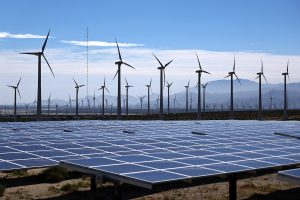
PALM SPRINGS, CALIFORNIA – MARCH 06: Wind turbines operate at a wind farm near solar panels on March 06, 2024 near Palm Springs, California. (Photo by Mario Tama/Getty Images)
Electricity is an integral part of our modern societies and systems. Appliances, lighting, heating, water filtration, healthcare, most everything you can think of needs electricity in order to function. So, it is understandable that people are wary of trying to disrupt any element of this system which so many of us take for granted. I am of course talking about the idea of transitioning our methods of electrical to carbon neutral or more environmentally friendly.
Today electricity production accounts for a third of all emissions in the U.S, a number which remains more or less true for most other highly developed nations. It also represents a golden opportunity to try and reduce our carbon emissions. Unlike many other sectors such as transportation and manufacturing, technology exists today to severely reduce the amount of carbon generated from our electrical production. Technologies such as solar panels and wind turbines, both of which have progressed immensely over the past few decades, allow us to generate large amounts of electricity with very little carbon emissions.
Both of these often get a lot of flak from those who oppose them; however, I do not believe it is deserved. If you look at the numbers on it, both their positive factors are impressive. Windmills present one of the biggest hopes for de-carbonization on a large scale. Being able to be constructed in a variety of places, they allow for the generation of large amounts of energy in many states.
Many plains states have invested heavily in wind, with some states like Iowa now generating most of their power from wind; 58 percent as of 2020-2021. Wind mills also offer the ability for mixed use in many states where large amounts of open land may not be available as they can be placed in fields which are already being used for agricultural purposes with minimal losses to the ability to farm the land around it. Other projects, such as offshore wind, also show immense promise, as large global initiatives, such as those in the North Sea, are paving the way to provide clean power to many areas which would not be able to generate it on land otherwise.
Solar panels also prove an interesting case. While not quite as efficient as windmills at grid scales, they do offer one key benefit: flexibility. This allows just about anyone anywhere to help to try and reduce their carbon emissions. While individually this does not make a huge difference, together all our small actions become real, actionable changes which we can see in our lives. Since the source of electricity is often very local, it can also help to reduce electrical loss during transport, a serious amount of electricity which simply never will make it to the consumer. Reducing this reduces the total amount we need to generate, making it easier to de-carbonize.
We have already had successes, such as the fact that almost all new US grid capacity over the past 25 years has been added by renewables such as wind and solar, and that many of the worst offenders such as coal fired plants are shutting down. We have come a long way, but we have still got a long way to go.
